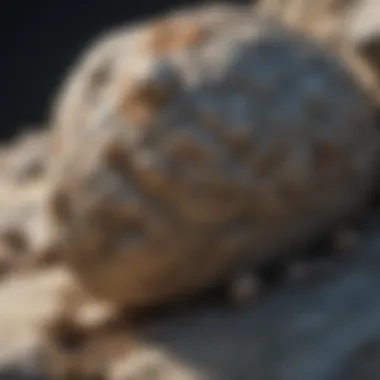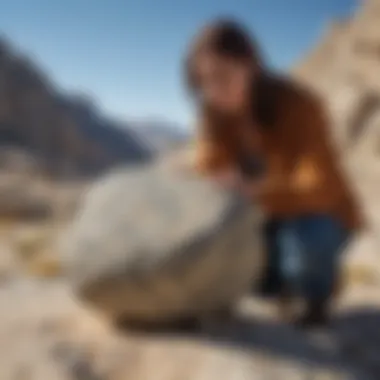Unveiling the Enchantment of Granite: A Comprehensive Guide to Its Beauty and Significance in the World of Rock and Fossil Collecting


Rock and Fossil Identification
Granite, a coveted specimen in the realm of rock and fossil collecting, boasts distinct characteristics that set it apart from other rocks and minerals. When identifying granite, collectors should observe its granular composition, typically comprised of minerals like feldspar, quartz, and mica. The interlocking crystals give granite its signature speckled appearance, varying in color from pink to gray to black. To aid in identification, collectors can utilize tools like hand lenses and geology hammers to examine mineral content and structure.
Geological Insights
Delving deeper into the geological insights of granite reveals a rich history etched in its formation. Often found in continental crust areas, granite results from the slow cooling of molten rock beneath the Earth's surface. This process, known as plutonism, contributes to granite's coarse-grained texture and durability. Throughout history, granite has been revered for its robust nature, with notable occurrences in ancient structures like the Pyramids of Egypt and the towering peaks of mountain ranges worldwide. Renewed interest in geological formations continues to unearth new discoveries and shed light on the significance of rocks and fossils in shaping our understanding of the Earth's past and present.
Preservation and Display
Preserving granite specimens requires meticulous care to maintain their integrity and beauty. Enthusiasts can employ various techniques such as sealing with protective coatings to prevent erosion and discoloration. Proper storage methods involve storing granite in a dry, stable environment away from direct sunlight to avoid degradation. When it comes to creative display ideas, collectors can showcase their granite treasures using aesthetically pleasing stands or encasements that highlight the intricate patterns and colors within the rock. By incorporating preservation practices and innovative display solutions, collectors can ensure that their granite specimens retain their allure for generations to come.
Introduction to Granite
Granite holds a prominent position in the world of collecting rocks and fossils, serving as a cornerstone for enthusiasts and collectors alike. This section delves into the foundational aspects of granite, shedding light on its significance and allure within the geological spectrum. By unveiling the origins, composition, and characteristics of granite, this guide aims to provide a thorough understanding of this captivating rock for aficionados looking to enrich their knowledge and appreciation.
Origins of Granite
Formation Process of Granite
The formation process of granite is a crucial element that shapes its unique properties and desirability among collectors. Exploring the intricate mechanisms behind its creation reveals a fascinating journey of molten rock crystallization and geological forces at play. Understanding the formation process not only enhances our comprehension of granite's physical attributes but also underscores its rarity and intrinsic value in the world of collecting rocks and fossils.
Geological Factors Contributing to Granite Formation
Geological factors play a pivotal role in the genesis of granite, influencing its composition and structural characteristics. From tectonic movements to temperature variations, a myriad of geological forces interact to form this enchanting rock. By dissecting the intricate interplay of these factors, we can appreciate the complex processes that result in the diverse array of granite formations found across the globe, enriching our exploration and collection endeavors significantly.
Composition of Granite


Mineral Composition of Granite
The mineral composition of granite serves as a foundational aspect that defines its unique identity and allure for collectors. With an intricate blend of minerals such as feldspar, quartz, and mica, granite embodies a harmonious fusion of geological treasures. Exploring the distinct properties of each mineral within granite offers enthusiasts a deeper appreciation for its aesthetic beauty and geological significance, elevating the value of these specimens in the realm of rock and fossil collecting.
Variations in Granite Composition
Delving into the variations in granite composition unveils a rich tapestry of colors, patterns, and textures that distinguish different granite specimens. Whether it's the presence of biotite creating dark speckles or the absence of hornblende leading to lighter hues, these variations offer collectors a diverse palette to explore and admire. By elucidating the factors that contribute to these compositional differences, we gain a holistic view of granite's versatility and allure in the collecting world, paving the way for informed and enriching collecting experiences.
Characteristics of Granite
Granite, as one of the most sought-after rocks in the realm of collecting rocks and fossils, boasts a plethora of distinctive characteristics that make it a captivating choice for enthusiasts. Understanding the specific elements and nuances of granite's composition is crucial in appreciating its allure. In this article, we will delve deep into the essential aspects that define the beauty and significance of granite, shedding light on its unique traits that set it apart from other rocks.
Texture and Color Variations
Different Textures Found in Granite
Exploring the tactile dimensions of granite reveals a mesmerizing array of textures, ranging from coarse and grainy to smooth and polished. Each texture carries its own visual appeal and adds a layer of complexity to granite's aesthetic charm. The interplay between different textures contributes to the overall character of granite specimens, making them versatile choices for collectors seeking diversity in their collections.
Color Spectrum of Granite
The color palette of granite is a sight to behold, showcasing a spectrum that spans from earthy tones of browns and greys to vibrant hues of reds, blues, and greens. This diverse range of colors makes granite a versatile option for collectors looking to add variety to their displays. The unique feature of granite lies in its ability to exhibit intricate patterns and speckles, creating visually stunning specimens that stand out in any collection.
Durability and Strength
Factors Impacting Granite Durability
The durability of granite is influenced by various factors, including its mineral composition, formation process, and environmental exposure. These aspects play a crucial role in determining how well granite withstands external forces and retains its appearance over time. Understanding the key factors that affect granite's durability is essential for collectors seeking long-lasting specimens that can withstand the test of time.
Comparison to Other Rock Types


When comparing granite to other rock types, its exceptional durability and strength become evident. Granite surpasses many rocks in its ability to resist scratching, staining, and heat damage, making it a preferred choice for applications that require robust materials. By examining how granite stacks up against other rock types, collectors can gain a deeper appreciation for its unique qualities and practical advantages.
Significance of Granite in Collecting
In the realm of rock and fossil collecting, granite holds a significant place due to its unique properties and aesthetic appeal. Collectors are drawn to granite for its geological significance and beauty, making it a sought-after addition to any collection. Granite's durability and wide range of textures and colors make it a versatile choice for collectors looking to diversify their specimens. Moreover, the long-standing popularity of granite in various industries adds to its appeal among collectors, showcasing its timeless charm and versatility in different applications. Understanding the significance of granite in collecting provides enthusiasts with a deeper appreciation for this natural stone and its contribution to the world of rock and fossil collecting.
Popular Types of Granite Collections
Rare Granite Varieties
When it comes to rare granite varieties, collectors are often intrigued by the unique characteristics and limited availability of these specimens. Rare granite varieties offer collectors the opportunity to own prized pieces that stand out in terms of exclusivity and rarity. The distinct patterns, colors, and formations found in rare granite varieties make them highly desirable among collectors seeking unique additions to their collections. While rare granite varieties may require more effort to acquire, their scarcity adds value and intrigue to any collection, enhancing its overall appeal and exclusivity.
Unique Geological Formations
Unique geological formations in granite collections showcase the intricate patterns and formations that have been naturally sculpted over time. These formations provide collectors with a glimpse into the fascinating geological processes that have shaped the earth's surface, offering a deeper understanding of the forces at play. Collectors are often captivated by the intricate details and natural beauty found in unique geological formations, appreciating the geological significance and aesthetic allure they bring to their collections. The unique features of these formations add a layer of complexity and sophistication to granite collections, enriching the overall experience for collectors and enthusiasts alike.
Techniques for Identifying Granite
Granite identification techniques play a crucial role in helping collectors differentiate between various types of granite and assess the quality of their specimens. Key features for granite identification focus on factors such as mineral composition, texture, and color, providing collectors with valuable insights into the unique characteristics of each specimen. By understanding key features for granite identification, collectors can accurately classify and categorize their specimens, enhancing their knowledge and appreciation of granite in collecting.
Tools Used in Granite Analysis
Tools used in granite analysis offer collectors the ability to conduct in-depth examinations of their specimens, allowing for detailed assessments of mineral composition, texture, and structural characteristics. From magnifying lenses to chemical tests, these tools provide collectors with a comprehensive toolkit for analyzing and studying granite specimens with precision. By utilizing tools for granite analysis, collectors can uncover hidden details, identify rare features, and gain a deeper understanding of the geological history and significance of their granite collections. These tools act as essential aids in the exploration and preservation of granite specimens, enriching the collecting experience and enabling collectors to make informed decisions about their collections.
Collecting and Preserving Granite Specimens
In this comprehensive guide on the allure of granite in the world of collecting rocks and fossils, the section on Collecting and Preserving Granite Specimens holds significant importance. This segment delves into the meticulous process of acquiring and safeguarding granite specimens for enthusiasts and collectors. It emphasizes the key role played by collecting and preserving techniques in maintaining the integrity and value of these geological treasures.


Best Practices for Collecting Granite
Field Collection Tips: When it comes to Field Collection Tips, meticulous attention to detail is paramount. This aspect of the collecting process focuses on strategies for responsibly and effectively gathering granite specimens. The significance of Field Collection Tips lies in ensuring the authenticity and quality of the acquired rocks, enhancing the overall experience for collectors. By outlining the best practices for harvesting granite in its natural environment, this section sheds light on the nuanced methods utilized by seasoned collectors.
Ethical Considerations: Ethical Considerations play a crucial role in the realm of granite collection. This aspect underscores the importance of sustainable and ethical practices in acquiring specimens. By highlighting the ethical implications of collecting granite, this section promotes a thoughtful approach to preserving the geological landscape for future generations. It explores the ethical dilemmas surrounding rock collection and encourages collectors to adopt responsible behaviors that align with conservation efforts.
Preservation Techniques for Granite
Cleaning and Maintenance: The Cleaning and Maintenance of granite specimens is a meticulous process that ensures the longevity and aesthetic appeal of these geological treasures. Comprehensive cleaning techniques are essential for preserving the natural beauty of granite, maintaining its integrity, and preventing degradation over time. By detailing the best practices for cleaning and maintaining granite, this section equips collectors with the knowledge needed to preserve their specimens effectively.
Display and Storage: Display and Storage techniques for granite specimens are essential for showcasing these geological wonders in all their splendor. The selection of appropriate display methods and storage solutions is crucial in highlighting the unique characteristics of each specimen while ensuring their protection from environmental factors. By exploring the various options available for displaying and storing granite, this section offers insights into enhancing the visual impact and longevity of collectible specimens.
Utilization of Granite in Various Industries
Granite is a versatile and prized material that finds extensive utility across various industries due to its exceptional properties and aesthetic appeal. Its relevance in construction, design, and artistic endeavors highlights the immense value of granite in today's industrial landscape. The utilization of granite in different sectors showcases its durability, beauty, and adaptability.
Architectural Applications
Use of Granite in Construction
The use of granite in construction is a cornerstone of architectural excellence. Renowned for its strength and longevity, granite stands out as a premium choice for building materials. Its natural beauty, coupled with its resilience against weathering and wear, makes it a favored option for structures requiring both functionality and elegance. The key characteristic of granite in construction lies in its ability to withstand the test of time, offering a durable and visually striking solution for various architectural projects.
Design Trends
In contemporary design trends, granite takes center stage as a popular choice for its versatility and sophistication. From sleek countertops to stylish flooring, granite effortlessly elevates the aesthetic appeal of any space. Its unique patterns and color variations provide a level of customization that is unmatched by other materials, allowing designers to create distinct and personalized environments. The adaptability of granite to different design styles ensures its continual relevance in modern interior and exterior design.
Cultural and Historical Significance
Monuments and Sculptures
Granite's influence stretches beyond mere practical applications to the realm of cultural and historical landmarks. Monuments and sculptures crafted from granite embody artistry, memorialize significant events, and pay tribute to distinguished figures. The enduring nature of granite ensures that these structures stand the test of time, preserving the heritage and stories they symbolize. The unique feature of granite monuments lies in their ability to evoke emotions, commemorate history, and commemorate the legacy of individuals or events in a tangible and lasting form.
Symbolism of Granite
The symbolism attached to granite goes beyond its physical attributes, encompassing themes of strength, endurance, and permanence. Granite symbolizes stability and solidity, making it a popular choice for monuments, gravestones, and other commemorative structures. Its natural beauty and timelessness create a sense of reverence and respect, establishing granite as a material that carries profound significance in cultural and artistic contexts. The enduring symbolism of granite resonates with generations, transcending time and connecting past, present, and future through its enduring presence.







